.
.
Happy Birthday #104 to Roy Eldridge, who in addition to being one of the great trumpet players of his time, is known as the “bridge” between Armstrong and Dizzy. I loved the brightness of his playing, and for contributing to one of the great moments in jazz — his vocal duet with Anita O’Day, leading into a seldom-in-a-generation trumpet solo on “Let Me Off Uptown.”
When I was a kid, my dad used to tell me stories about his friendship with “Eldridge,” and in particular one eventful experience he had while he was traveling with his band in Pennsylvania. In 1998, two years before his passing, my father wrote this piece for Jerry Jazz Musician about this very special experience in his life. I hope you enjoy his telling of it…
.
___________
.
My name is Joe Maita, Sr. I am 81 years old and was a musician for
many years. This is about my experience meeting and knowing the great
trumpet player Roy Eldridge.
Roy was born on January 30, 1911 in Pittsburgh Pa. One of the most exciting
trumpeters to emerge during the swing era, Roy Eldridge’s combative approach,strong musicianship were an inspiration and influence to the next musical generation, most notably Dizzy Gillespie. Although he sometimes pushed himself farther than he could go, Eldridge never played a dull solo.
Roy Eldridge started out playing trumpet and drums in carnival & circus
bands. He would not discover Louis Armstrong for a few years. He worked withbands of Zack Whyte and Speed Webb in 1931. He worked with Elmer Snowden
who nicknamed him “Little Jazz” also McKinney’s Cotton Picker’s and most
importantly Teddy Hill in 1935. Eldridge recorded solos with Hill backing
Billie Holiday and with Fletcher Henderson including his 1936 hit, “Christopher
Columbus” gained a great deal of attention.
In 1937 he appeared with his octet with his Brother Joe on Alto Sax at the
Three Deuces Club in Chicago. His group recorded some outstanding selections
as a leader, including: “Heckler’s Hop” & “Wabash Stomp”.
The Summer of 1938, I was playing with the Joaquin Grill Orchestra at the
Willows at Oakmont Pa. on the Allegheny River. One night after we finished
playing at 1:00 a.m. my friends, Louis Mitchell trpt. and Cliff Fishback
our arranger and piano player, decided to go into Pittsburgh about 15 miles
away to a Jazz Club . It was a place where some of the local jazz players
would go to jam. It all would start late at night and could go on till the
wee hours of the morning. We arrived around 1:45 a.m. and the place was nothing much to look at. We walked up a full flight of stairs and our ears told us
that we arrived at the right place. It was jumping with some great sounds.
As we walked into the room where all the music was coming from, we couldn’t
see a thing because the room was filled with cigarette smoke. As we looked
around for a place to sit, the band started up again. It sounded fine, but
when the trumpet player started up we realized that it was the great Eldridge.
What a surprise. Roy was one of our favorite players and here we were in
the same room with him.
Roy Eldridge and his Band had just finished a long engagement at the ‘Three
Dueces’ a famous Jazz Club in Chicago. They had a lot of air time broadcasting
from that spot and we would always try to hear him whenever we could get
near a radio from where ever we would be. He was our favorite jazz player.
We found out that Pittsburgh was his home and that he actually was born there.
It was our luck to walk in on this unexpected treat…. Of course when
the music group took a break, we invited Roy over to our table and we had
a great time meeting each other and discussing the music business in
general…Roy introduced his brother, Joe Eldridge to us at this time.
Joe was a fine alto sax man and also arranged music for some of the big bands. One band he arranged for was Bob Crosby and his Bob Cats, Bing’s brother,
who had a fine band at the time. It was a happy night for all of us and it
ended up with Roy inviting us to his house across the river to hear his band rehearse on the next day.
Of course Cliff, Lou and I went to hear the band rehearse at Eldredge’s home the next afternoon. His home was across the Allegheny River in an industrial area near the Heinz Ketchup factory…As we entered Roy’s house we could hear his band playing and it sounded great, even with the smell of ketchup
in the air it was a memorable experience…The band sat around in a relaxed
manner and without music stands played head arrangements. We enjoyed the
day…
We invited Roy and his Brother Joe to our home in Oakmont for a dinner that
I would cook. Cliff, Lou and I rented this beautiful brick home for the summer
while we were playing the music job at the Willows. I must say that renting
this home was probably the best deal anyone could have. It so happened that
this elegant home belonged to two elderly women that were going to Europe
for the summer and as our engagement at the famous Willows was booked for
the summer, we were able to rent this home…It was completely furnished
with beautiful furniture in all the rooms on two floors and all the dishes,
pots and pans, and silverware included for the unheard of sum of $90.00 per
month (unbelievable even for 1938.) and linens too…We split the cost
4 ways, Cliff, Lou, myself and Joe Bruhl & wife Vera. As I remember,
I think we took good care of the place.
Roy and Joe Eldridge came over for dinner the next afternoon. We enjoyed
each others company talking about the music business in general…Roy
told me that when he first started playing the trumpet he didn’t even have
a trumpet lesson book, but he used his brother Joe’s clarinet music book
to learn. We also took several pictures together with our cameras. I served
an Italian dinner that everyone seemed to enjoy.
By 1939 Roy had a larger group playing at the Arcadia Ballroom in New York.
With the decline of Bunny Berigan and the increasing predictability of Louis
Armstrong, Roy Eldridge was arguably the top trumpet player in jazz during this era.
During 1941-1942, Eldridge sparked the GENE KRUPA ORCHESTRA recording a classic version of ‘Rockin Chair’ and ‘After you’ve gone’ and interacting with Anita O’Day on the great recording of “Let Me Off Uptown”.
It was about this time that the Gene Krupa Band was riding on a high as a
bandleader, came to Sacramento, California. It was September of 1941 and
Krupa’s Band with Anita and Roy were engaged to do a show at the California S
tate Fair. By coincidence I was hired to play in the State Fair Concert
Orchestra. It was 3 years since I had seen Roy and I was looking forward
to see him again. After I finished my job that night, I went where the Gene
Krupa Band was performing and after they finished their show I went backstage
and there was ‘Little Jazz’. It was good to see him and we talked about going
somewhere to visit. He introduced me to some of the musicians and the famous
Anita O’Day. Meanwhile Roy said that the Band members were going downtown
to the Senator Hotel where they were going to stay for the night, but because
he was a black man he would not be able to stay with the rest of the band
and would look around and see where to stay for the night. I said “Roy, you
will stay with me.” I know that Roy remembered Lou Mitchell from our meeting
in Pittsburgh and told him that I had a place in his family home with Lou’s
mother, Mrs. Mitchell…Lou was working in the music studios of Hollywood
at the time.
Roy said that would be great . We went home and after a good nights rest
I went upstairs to the main floor where Mrs. Mitchell would be in the kitchen
and told her “Guess what Mrs. Mitchell? Roy Eldridge is downstairs in my
room he stayed with me last night. Can you believe he is the star of the Gene Krupa Band and he couldn’t even stay at the hotel with the rest of the band because he is black?” Mrs. Kate Mitchell knew all about Roy Eldridge as she was aware of all the famous musicians at the time. Having two sons, Lou (trumpet) and Andy (trombone) she knew all about the existence of the music greats at the
time: Ellington, the Dorsey Brothers , Goodman, Armstrong and so on…She
asked me, “What do you think he would like for breakfast?” How about your
scrambled eggs cooked in the great Mitchell Olive Oil and bacon would be
good.
I went downstairs to get Roy and as we started up the stairs, which was on
the out side of the house, there were some large Pyracantha shrubs full of
orange berries. This was Roy’s first time in California and he looked at
the little orange berries and said, ” Man! look at the baby oranges.” We
had a nice breakfast with Mrs. Mitchell then took Roy to join the rest of
the band as they were to continue on to their next engagement .
The difficulties of a black musician traveling with a white band during a
racist period hurt him as did some of the incidents that occurred during
his stay with the Artie Shaw Orchestra 1944-1945, but the music during both stints was memorable. He toured with Jazz at the Philharmonic and a successful
stay in France during the years 1950-1951. He recorded steadily for Norman
Granz in the 1950’s. On Jazz at the Philharmonic he battled the famous trumpeters Charlie Shavers and Dizzy Gillespie and teamed up with Coleman Hawkins tenor sax great in a quintet. Roy Eldridge in the 1960’s put in a time with the Count Basie Band.
After my meeting with Eldridge in Sacramento in 1941 I didn’t see Roy until
he came to San Francisco in the late 1960’s. He was Ella Fitzgerald’s conductor,
manager, and trumpet star. They were in the Venetian Room of the Fairmont
Hotel. I went over to see them and when Roy saw me he hugged me and told
Ella about me and my putting him up for the night when he couldn’t get a
room at the same hotel as the rest of the band.
It was just before showtime and Roy walked me across the dance floor to a
single table in front of the bandstand to see Ella’s show. We know she is
great. After her show she brought me her autographed picture, which I still
have hanging up on my family room wall.
Roy continued on thru the 1970’s . Only a serious stroke in 1980 was able t
o halt his horn. Roy Eldridge recorded throughout his career for virtually
every label.
Roy passed away on February 26, 1989 at Valley Stream N.Y.
.
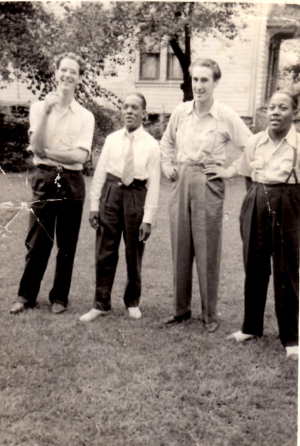
Cliff Fishback, unknown member of Roy Eldridge’s band, Louis Mitchell, and Roy Eldridge
Oakmont, Pennsylvania
Summer, 1938
Photo taken by Joseph Maita, Sr.
_____
Krupa, Anita, and Roy play “Let Me Off Uptown”
.
.
Click here to read my interview with Roy Eldridge biographer John Chilton
.
.
.






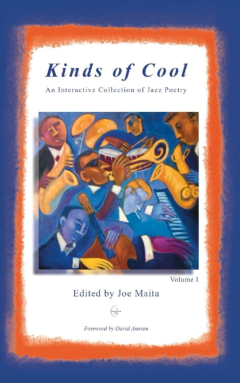

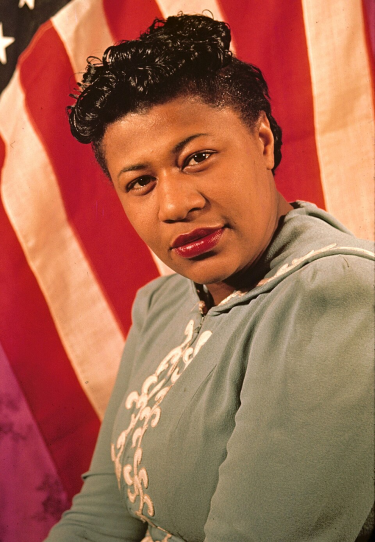















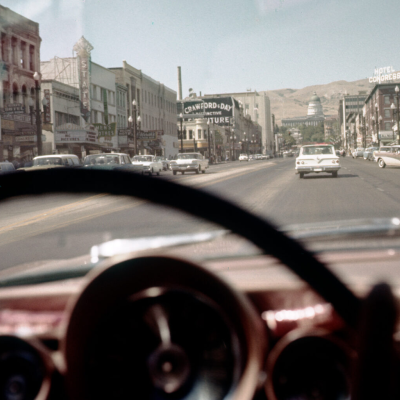


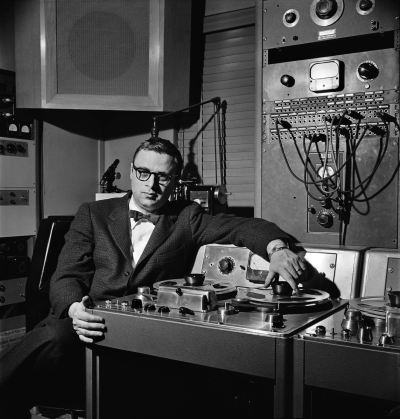












What a wonderful true-life story, and how exciting it must have been for JM: senior. I felt his excitement in reading the story. The music scene is so bland these days. It seems hollow, like maybe the wind was suctioned out of it ….
Greed was the villain…Greed.
Greed was the villain…Greed.
He remembered a lot of great details. I loved the bit about tiny oranges.
He remembered a lot of great details. I loved the bit about tiny oranges.
Thanks for sharing such a great, personal story from your father.